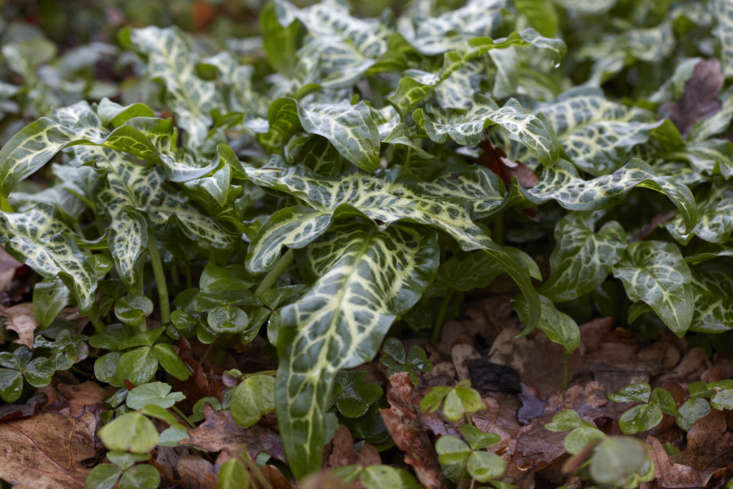Italian Arum, Arum Italicum: “Italian Marble”
Italian Arum is companionable and well-behaved in a tapestry of ground covers—at least in Europe. In areas that are shady and a little damp, the marbled spearheads of Arum italicum can be invaluable in winter and spring.
The variety shown here, Arum italicum ‘Marmoratum’, holds an Award of Garden Merit from the Royal Horticultural Society. Its spotted, less textured cousin Arum maculatum is considered feral and is mainly avoided. This can be confusing; They share the nickname “Lords and Ladies” and are both toxic. Additionally, in parts of the United States they are both invasive. Let’s focus, then, on Italian arum in its happy place: a pampered woodland garden in Essex, England.
Photography by Britt Willoughby Dyer for Gardenista.

Along a path into the woodland of Beth Chatto’s gardens in Essex, shiny leaves of Arum italicum combine with the gloss of burgundy Bergenia, They provide a distraction from spent snowdrops while contrasting with emerging brunnera in the foreground.
For other uses of Bergenia, see Elephant’s Ears: Rethinking Bergenias in the Garden.

Leaf litter is good for the garden; it harbors invertebrates and breaks down into a nutritious humus that keeps soil moist. If you think of decaying leaves as a positive feature of the garden in winter and spring, then it follows that you will want something with vitality as a complement: A. italicum.

Variegated leaves are nothing to be worried about in the sure hands of Beth Chatto. Here, strong marbling of Italian arum mingles with gently spotted lungwort. The shot of blue flowers makes this combination sing.

Cheat Sheet
- Think of Arum italicum as an alternative to Vinca minor, providing a handsome variegated foil to other foliage and spring flowers.
- Plant it where you have evergreen or deciduous shrubs so that it weaves around them, before disappearing in summer.
- In autumn, cylinders of bright red berry clusters emerge on leafless stalks.

Keep It Alive
- Shade and moisture are essential, with some sunshine.
- A north-facing garden that is not in deep shade, or areas under the lighter canopy of trees is ideal.
- In Europe, natural checks and balances keep it under control. In, say, Oregon, this non-native is a bit too comfortable.

Are you brave enough for the above combination? Wood sorrel and even mint can be useful as ground cover if planted with caution (mint needs to be contained). In a north-facing situation, Arum italicum combined with either of them will look purposeful and confident, although they will need some confident handling.
See more of our favorite perennial ground covers in our curated Ground Covers 101 guide, with growing tips and design ideas for Ivy, Thyme, Bacopa, Lungwort, and more. (We’re adding new ground covers and Perennials 101 every week to our Garden Design 101 guides. If there’s a plant you’d particularly like us to add to our guides, please let us know in the comments section.)












Have a Question or Comment About This Post?
Join the conversation (2)